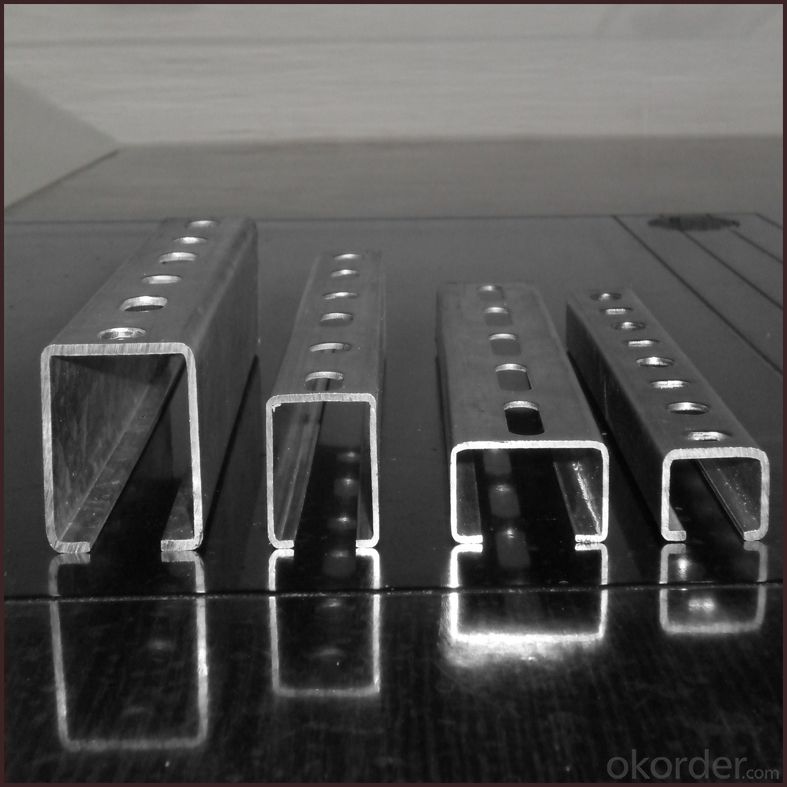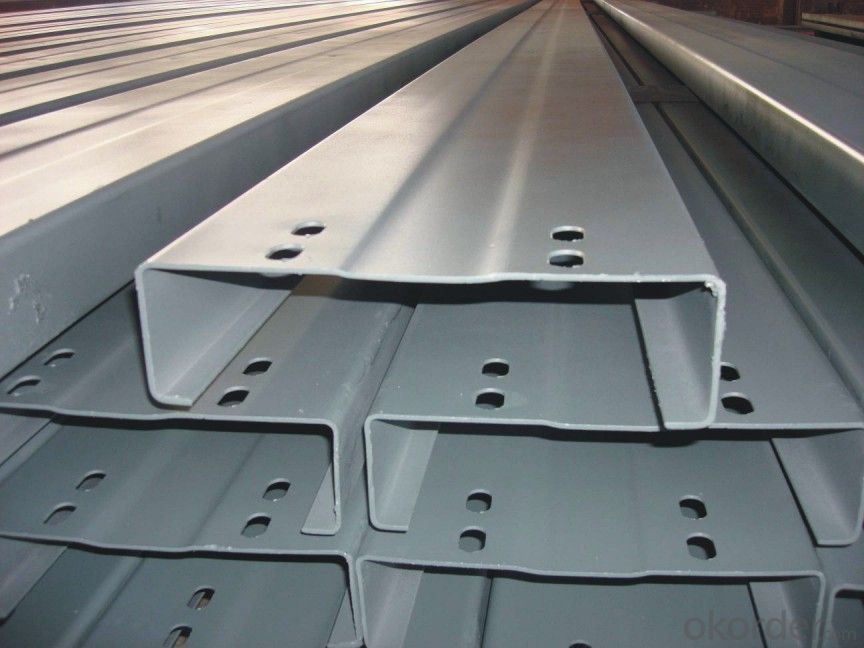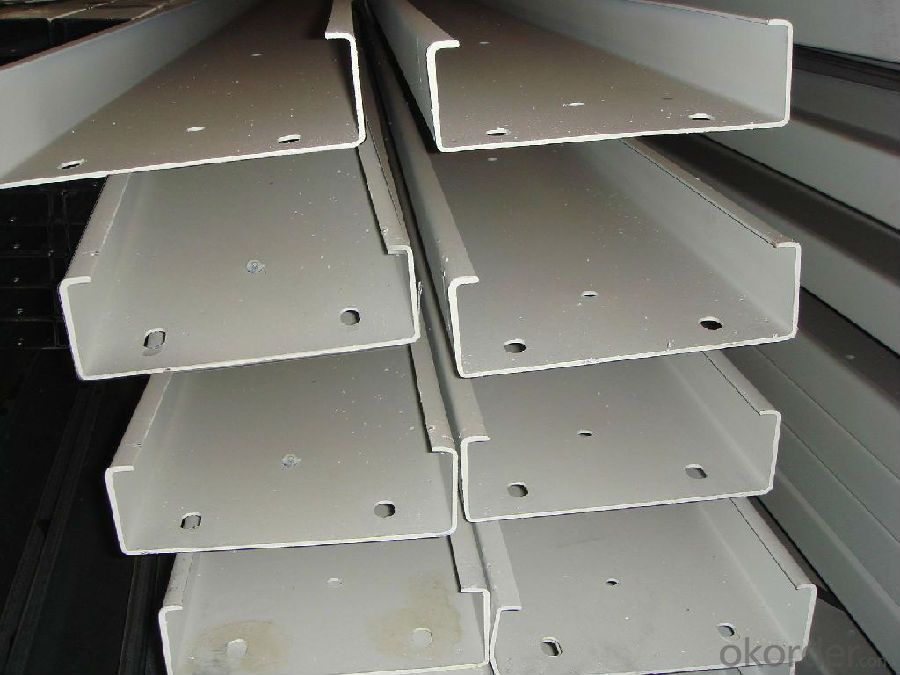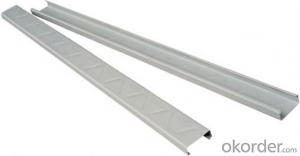C Channel Hot dipped Galvanzied Unistrut Channel
- Loading Port:
- Tianjin
- Payment Terms:
- TT or LC
- Min Order Qty:
- 28 m.t.
- Supply Capability:
- 30000 m.t./month
OKorder Service Pledge
OKorder Financial Service
You Might Also Like
1,Structure of C Channel Hot dipped Galvanzied Unistrut Channel
Our factory main produce steel profile of suspended ceiling system and drywall partition system, including drywall stud & track, ceiling main & cross tee, wall angle, C-channel, Omega, Accessories etc.
1> Our series products main supply to Eastern Europe like Russia, Ukraine etc.
CD60*27
UD28*27
CW50*50, 75*50, 100*50
UW50*40, 75*40, 100*40
2,Main Features of C Channel Hot dipped Galvanzied Unistrut Channel
2> Our series products main supply to Middle East.
C-Channel 38*12
Omega 68*35
Stud 41*35, 50*35, 63*35, 70*32, 70*34.5, 75*35, 100*35
Track 41*25, 50*25, 63*25, 72*25, 75*25, 100*25
Angle 25*25
3> Our series products main supply to Australia, New Zealand.
Top Cross Rail 25*21
Furring channel 28*38, 16*38
Furring channel track 28*20*30,16*20*30
Stud 51*33.5*35.5,64*33.5*35.5, 76*33.5*35.5, 92*33.5*35.5, 150*33.5*35.5
Track 51*32*32, 64*32*32, 76*32*32, 92*32*32, 150*32*32
Length and thickness can be customized as customers request
Material: high-quality hot dipped galvanized steel coil.
Advantage of C Channel Hot dipped Galvanzied Unistrut Channel
High quality & reasonable Price, no need welding and punching, can use repeatedly, wide usage range, flexible for installation.
1. Strut Channel Standard Size: 21*21, 41*21, 41*25, 41*23, 41*41,41*62,41*72,41*82
2. Strut Channel Standard thickness: 1.5mm, 2mm, 2.5mm,2.75mm, 3.0mm
3. Strut Channel length: 2440mm, 3000mm, 5800mm, 6000mm and customized
4. Strut Channel Standard Type: back to back, 41*41.41*62, 41*123 and so on
5. Strut Channel Standard Hole Size:14x29mm, 10x76mm,22mm,14mm.
6. Strut Channel Standard Model: Slotted / Perforated / Punched Hole, and Solid.
7. Strut Channel Standard Material: Q235B, Stainless Steel, Aluminum.
8. Strut Channel Standard Surface Finish: Black, Pre-galvanized, Hot Dipped Galvanized,Electro Galvanzied,
SS304, SS304L,SS316,SS316L, Aluminum, Painted Color / Powder Coated.
9. Strut Channel Availble Doucments: Catalogues, Drawings, Photos, Price List, Certificates, Test
Report, Factory Inspecition, After-sales Service and So on.
10. Strut Channel Standard Delivery Time: 7 working days for 1x20ft Container.
Other sizes be produced according to customer’s drawing.
Images of C Channel Hot dipped Galvanzied Unistrut Channel



- Q:How do steel channels contribute to the overall durability of a building?
- There are several ways in which steel channels enhance the durability of buildings. Firstly, their high strength and rigidity make them a reliable choice. Made from structural steel, which has exceptional load-bearing capabilities, steel channels offer strong support and prevent structural failure, ensuring the longevity of the building. Secondly, steel channels exhibit remarkable resistance to corrosion and rust. Unlike materials like wood or concrete, steel does not deteriorate over time when exposed to moisture or harsh weather conditions. This resistance to corrosion maintains the building's structural integrity, even in challenging environments or coastal areas. Moreover, the use of steel channels allows for greater design flexibility and versatility in construction. Architects and engineers can easily cut, shape, and weld steel channels, enabling the creation of complex building structures with precision. This customizability enhances the overall durability of the building and ensures a tighter and more secure fit. Furthermore, steel channels possess excellent fire resistance properties. They are non-combustible and do not contribute to the spread of flames in the event of a fire. This is particularly crucial in high-rise buildings or structures where fire safety is of utmost concern. Including steel channels significantly reduces the risk of structural collapse during a fire, enhancing the overall safety and durability of the building. Finally, steel channels have a long lifespan and require minimal maintenance. Thanks to their inherent strength and resistance to deterioration, they can withstand the test of time without frequent repairs or replacements. This not only decreases long-term building maintenance costs but also guarantees the building's durability over many decades. In conclusion, steel channels play a vital role in enhancing the overall durability of buildings. They provide robust structural support, resistance to corrosion and rust, design flexibility, fire resistance, and long-term reliability. Including steel channels in construction projects strengthens the building, ensures its safety, and extends its lifespan, making them a critical component in ensuring the durability of modern structures.
- Q:Difference between steel channel and channel steel!
- It shouldn't make any difference, but I'm not sure.
- Q:Can steel channels be used for wall framing?
- Yes, steel channels can be used for wall framing. Steel channels are commonly used in construction for their strength and durability. They provide structural support and can be used as studs or tracks in wall framing systems.
- Q:I want to know what kind of steel is this type of steel, such as channel steel and die steel?
- Channel steel is Q235 and die steel is alloy steel
- Q:Are steel channels resistant to pests or termites?
- Steel channels possess a remarkable ability to withstand pests and termites. Unlike wood, which can be easily invaded by insects, steel channels create an unfavorable environment for these unwanted creatures. Termites cannot consume steel since it lacks cellulose, their main source of sustenance. Consequently, steel channels prove to be an exceptional option for construction endeavors in locations susceptible to pest or termite infestations. By ensuring enduring strength and safeguarding against such predicaments, they offer unparalleled reliability.
- Q:What is the minimum size of channel steel?
- Channel steel is a strip of steel with a cross section. Section steel with groove shape.
- Q:What are the factors to consider when determining the appropriate thickness of a steel channel?
- When considering the appropriate thickness of a steel channel, there are several factors that need to be taken into account. These factors include the load that the steel channel will bear, the length of the channel, the properties of the steel being used, and any relevant building codes or regulations. The load is the most crucial factor to consider. The steel channel must be able to support the weight or force placed upon it without bending or collapsing. The type and magnitude of the load, whether it is static or dynamic, and any potential impact or live loads should all be considered. Calculations or engineering analysis may be necessary to determine the appropriate thickness based on the expected load. The length of the steel channel is another important consideration. Longer spans require thicker steel channels to prevent deflection or sagging. The longer the span, the more potential there is for flexing, so a thicker channel will provide the necessary rigidity and support. The properties of the steel being used also play a role in determining the appropriate thickness. Different grades of steel have different strength and stiffness characteristics, which should be taken into account when selecting the thickness. Material properties such as yield strength, tensile strength, and modulus of elasticity should be considered. Furthermore, any relevant building codes or regulations should be considered. Local building codes often specify minimum thickness requirements for structural elements, including steel channels. These codes are in place to ensure the safety and integrity of the structure, so it is essential to comply with them. In conclusion, careful consideration should be given to factors such as the load, span, material properties, and building codes when determining the appropriate thickness of a steel channel. A comprehensive analysis should be conducted to ensure that the chosen thickness will provide adequate strength and support for the intended application.
- Q:Can steel channels be welded or joined together?
- Steel channels can indeed be welded or joined together. Welding is a widely utilized technique for connecting steel channels and establishing a robust joint. In this process, the steel channels are heated to a high temperature, causing the edges to melt and subsequently fuse together as they cool. This fusion creates a bond that is equal to, if not surpassing, the strength of the original steel. Alternative methods for joining steel channels include bolting or using specialized connectors. Nevertheless, welding is often the preferred choice due to its capability to produce a seamless and uninterrupted connection, leading to a more structurally stable joint.
- Q:What are the different bending techniques for steel channels?
- Steel channels can be bent using various techniques, depending on the desired outcome and the equipment at hand. Some popular bending techniques for steel channels are as follows: 1. Roll Bending: By passing the steel channel through a series of rolls, it can gradually be shaped into the desired form. Roll bending can be performed in different ways, such as pyramid rolling, which utilizes three rolls to create a pyramid shape, or double pinch rolling, which employs two rolls for a more uniform bend. 2. Press Bending: Utilizing a press machine, force is applied to the steel channel, resulting in its bending. This technique is often employed for smaller channels or when a tighter radius is required. Press bending can be executed with the aid of a V-die, ensuring a smooth bend, or a bottom bending die for more intricate shapes. 3. Induction Bending: This technique involves heating the steel channel to a specific temperature using an induction coil, making it more pliable. Once heated, a bending machine or a set of rolls is used to bend the channel. Induction bending is commonly used for large or thick steel channels that necessitate precise and consistent bends. 4. Rotary Draw Bending: A mandrel and a set of dies are employed in rotary draw bending to bend the steel channel. The mandrel is inserted into the channel to prevent wrinkling or collapsing during the bending process. This technique is often utilized for tight radius bends or when maintaining the structural integrity of the channel is of utmost importance. 5. Stretch Bending: By clamping the ends of the steel channel and applying force, it can be stretched over a mandrel or a form. Stretch bending is commonly employed for larger channels or when creating long, sweeping curves. Each bending technique offers its own advantages and limitations, and the choice of technique depends on factors such as the desired bend radius, the thickness of the steel channel, and the available equipment. It is crucial to consider the specific requirements of the project and seek guidance from professionals in order to determine the most appropriate bending technique for steel channels.
- Q:How do steel channels contribute to the overall safety of a structure?
- There are several ways in which steel channels contribute to the overall safety of a structure. To begin with, steel channels provide structural support and stability to the building. In the construction industry, they are commonly utilized as load-bearing members. This aids in the efficient and even distribution of the structure's weight. As a result, the building can withstand external forces like wind, earthquakes, and heavy loads without collapsing. The presence of steel channels creates a robust framework that enhances the building's overall safety and structural integrity. Moreover, steel channels play a critical role in fire safety. Steel is a non-combustible material, and when used as channels, it effectively prevents the spread of fire within the structure. In the event of a fire, steel channels act as fire barriers, limiting the movement of flames and heat to specific areas. This containment of fire helps minimize damage and provides occupants with more time to evacuate safely. Furthermore, steel channels exhibit exceptional resistance to corrosion and deterioration, making them highly durable and reliable. Unlike other materials, steel does not decay, distort, or degrade over time. This longevity ensures that the structure remains stable and secure in the long term, reducing the risk of accidents and structural failures. Additionally, steel channels are frequently utilized in the construction of seismic-resistant structures. Their impressive strength and flexibility allow them to absorb and dissipate seismic energy during earthquakes. This ability to withstand seismic forces helps to minimize structural damage and ensures the safety of the building's occupants. In conclusion, steel channels contribute significantly to the overall safety of a structure by providing structural support, fire resistance, durability, and seismic resistance. Their inclusion in construction enhances the stability, strength, and integrity of the building, guaranteeing the safety and well-being of its occupants.
1. Manufacturer Overview |
|
|---|---|
| Location | |
| Year Established | |
| Annual Output Value | |
| Main Markets | |
| Company Certifications | |
2. Manufacturer Certificates |
|
|---|---|
| a) Certification Name | |
| Range | |
| Reference | |
| Validity Period | |
3. Manufacturer Capability |
|
|---|---|
| a)Trade Capacity | |
| Nearest Port | |
| Export Percentage | |
| No.of Employees in Trade Department | |
| Language Spoken: | |
| b)Factory Information | |
| Factory Size: | |
| No. of Production Lines | |
| Contract Manufacturing | |
| Product Price Range | |
Send your message to us
C Channel Hot dipped Galvanzied Unistrut Channel
- Loading Port:
- Tianjin
- Payment Terms:
- TT or LC
- Min Order Qty:
- 28 m.t.
- Supply Capability:
- 30000 m.t./month
OKorder Service Pledge
OKorder Financial Service
Similar products
New products
Hot products
Related keywords




























